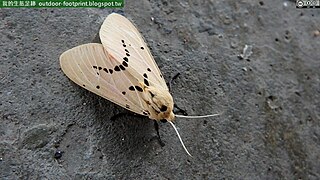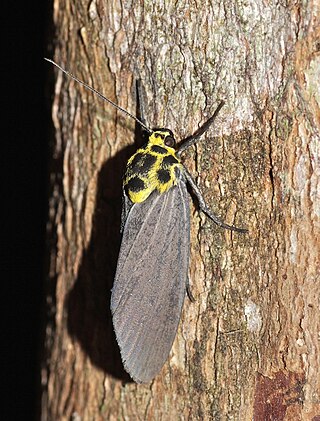
The Arctiinae are a large and diverse subfamily of moths with around 11,000 species found all over the world, including 6,000 neotropical species. This subfamily includes the groups commonly known as tiger moths, which usually have bright colours, footmen, which are usually much drabber, lichen moths, and wasp moths. Many species have "hairy" caterpillars that are popularly known as woolly bears or woolly worms. The scientific name Arctiinae refers to this hairiness. Some species within the Arctiinae have the word "tussock"' in their common names because they have been misidentified as members of the Lymantriinae subfamily based on the characteristics of the larvae.

The Arctiini are a tribe of tiger moths in the family Erebidae.

Brunia is a genus of tiger moths in the family Erebidae. The genus was erected by Frederic Moore in 1878.

Lyclene is a genus of lichen moths of the family Erebidae, subfamily Arctiinae. The genus was erected by Frederic Moore in 1860.

Spilarctia is a genus of moths in the family Erebidae. The genus was erected by Arthur Gardiner Butler in 1875.
Baroa punctibasalis is a moth of the subfamily Arctiinae. It was described by Wileman and West in 1928 and is found on the Philippines. The habitat consists of lowland secondary forests.

Baroa siamica is a noctuoid moth in the family Erebidae, subfamily Arctiinae. It is found in Thailand, Sundaland and Luzon in the Philippines. The habitat consists of lower and upper montane forests and lowland dipterocarp forests.
Baroa oryza is a moth of the subfamily Arctiinae. It was described by Karel Černý in 2011. It is found in the Philippines, where it is known from the mountains of central Mindanao. The habitat consists of primary mountain forests.
Lemyra praetexta is a moth of the family Erebidae. It was described by Karel Černý in 2011. It is found on the Philippines, where it has been recorded only from the mountains of Palawan.
Spilosoma virgulae is a moth in the family Erebidae. It was described by Karel Černý in 2011. It is found in the Philippines.
Spilarctia daltonica is a moth in the family Erebidae. It was described by Karel Černý in 2011. It is found in the Philippines.
Spilarctia mindanao is a moth in the family Erebidae. It was described by Vladimir Viktorovitch Dubatolov and Yasunori Kishida in 2010. It is found on Mindanao in the Philippines.
Spilarctia mollis is a moth in the family Erebidae. It was described by Karel Černý in 2011. It is found in the Philippines.
Spilarctia caloscopium is a moth in the family Erebidae. It was described by Karel Černý in 2011. It is found in the Philippines.
Spilarctia mahaplaga is a moth in the family Erebidae. It was described by Karel Černý in 2011. It is found in the Philippines.
Spilarctia ummeroides is a moth in the family Erebidae. It was described by Karel Černý in 2011. It is found in the Philippines.
Spilarctia brechlini is a moth in the family Erebidae. It was described by Karel Černý in 2011. It is found in the Philippines.
Spilarctia fidelia is a moth in the family Erebidae. It was described by Karel Černý in 2011. It is found in the Philippines.
Spilarctia harlequina is a moth in the family Erebidae. It was described by Karel Černý in 2011. It is found in the Philippines.
Spilarctia victorina is a moth in the family Erebidae. It was described by Karel Černý in 2011. It is found in the Philippines.






